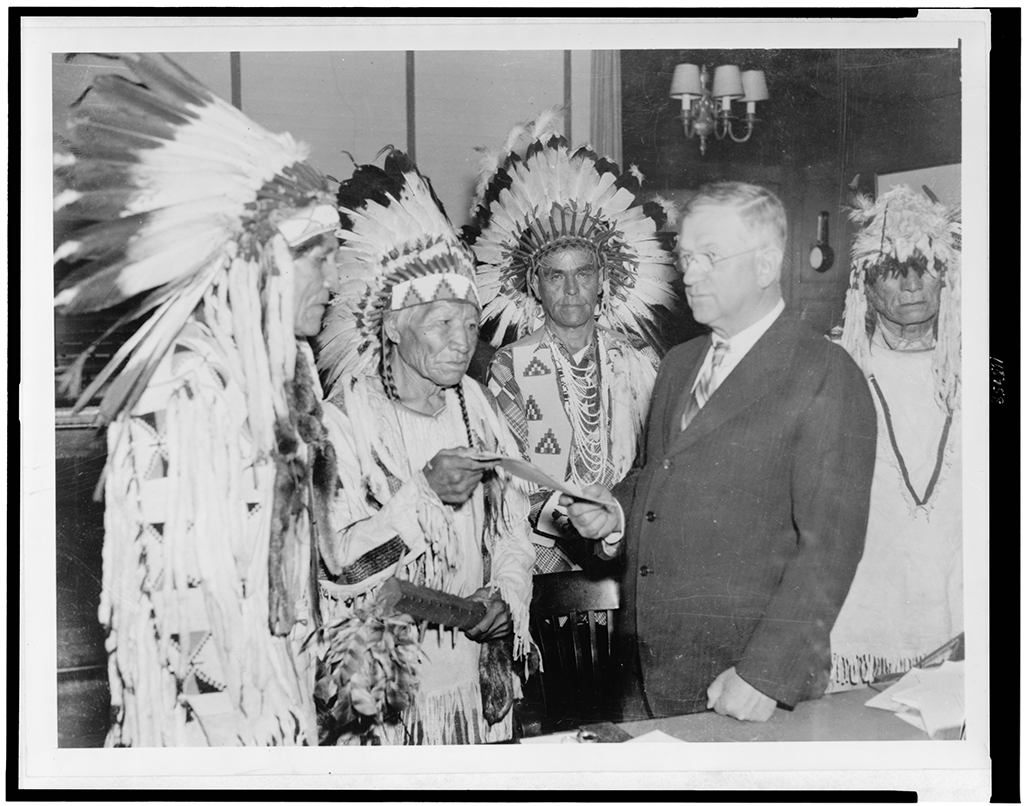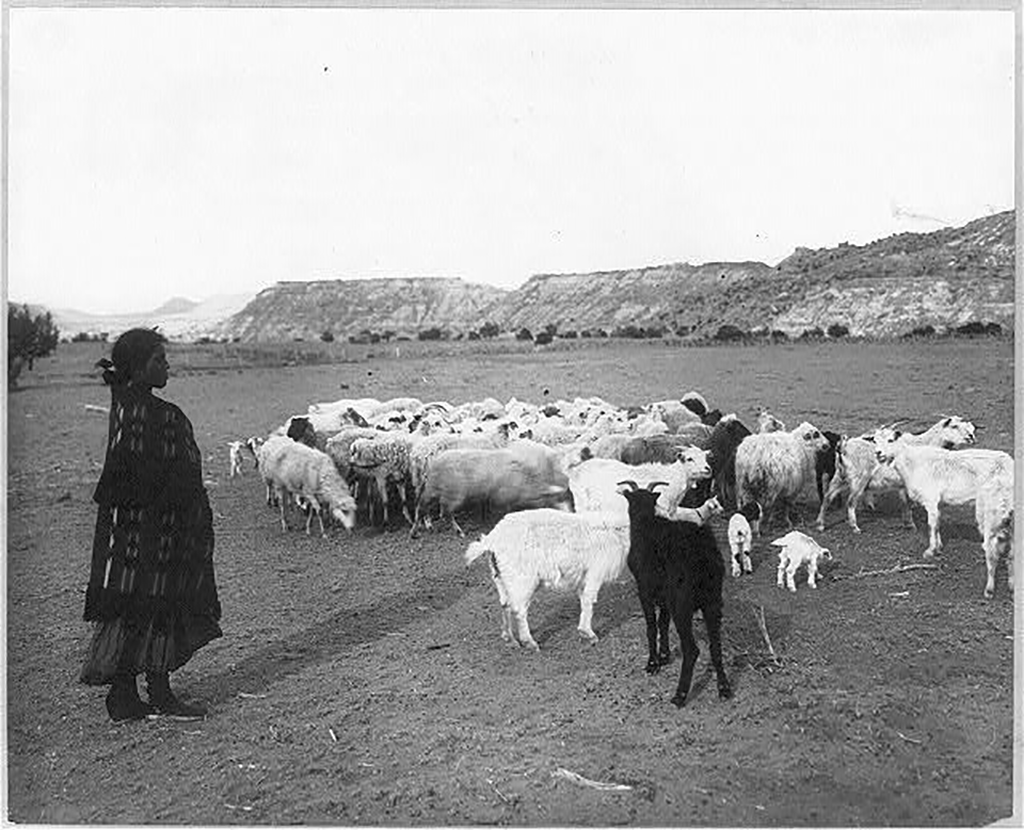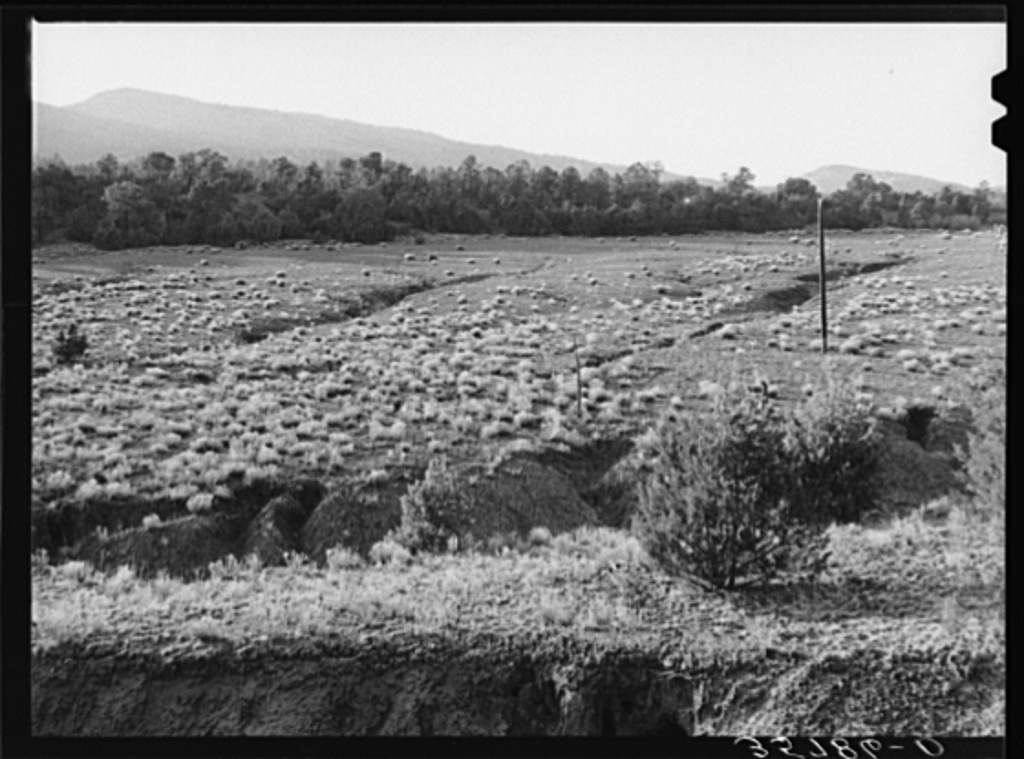The History of New Mexico
Collapse
Expand
-
Chapter 13: The Great Depression & The New Deal
- The Great Depression & The New Deal
- Artist Colonies & Rural Reformers
- Depression Comes to New Mexico
- Dennis Chávez & The Hispanic New Deal
- Indian New Deal & Navajos
- References & Further Reading
The Hispanic New Deal left a mixed record in New Mexico, as did the New Deal at the national level. Native Americans were another segment of the population that reformers designated for special attention during the Great Depression. President Franklin D. Roosevelt chose John Collier to head the Bureau of Indian Affairs (BIA) during his first administration due to his previous work among various Native peoples in New Mexico and the West.
As head of the BIA, Collier formulated plans for a national Indian New Deal. His experiences among the peoples of New Mexico convinced him that the Great Depression had impacted Native Americans particularly forcefully due to existing federal policies geared toward cultural assimilation. In 1934, he proposed the Indian Reorganization Act which dramatically reversed federal policies on Native land ownership and political rights that had been in place since the 1887 Dawes Severalty Act.

Courtesy of Library of Congress
The Indian Reorganization Act was the piece of legislation that provided for the Indian New Deal. The act terminated the federal assimilation program that included support for Native American boarding schools and the effort to break up communal lands in favor of individual ownership. Instead, it established a structure that would allow for native peoples to maintain their lands communally, if they wished, and have some political autonomy. Felix S. Cohen, a leading figure in federal Indian legal philosophy, drafted the law.
Under the Reorganization Act, Native tribes were able to create their own governments and constitutions. Their constitutions had to be approved by Congress, representing the limitations of indigenous self-determination. Only a decade earlier, on June 2, 1924, Congress had passed the Indian Citizenship Act. Prior to that time, Native Americans were not granted U.S. citizenship. The 1934 act was an attempt to further extend the promise of citizenship to Native peoples, and to return some of the lands that had been stripped from tribes under the provisions of the Dawes Severalty Act. About two-thirds of the 138 million acres held by Native Americans prior to the Dawes Act had been taken from them under its provisions.
In addition to the realignment of federal policy toward Native Americans, Collier and Secretary of the Interior Harold Ickes created a series of work and relief programs tailored specifically for reservations. The Indian CCC, for example, was segregated to include only Native American enrollees and camps were located on Native American lands.
Participants in the Indian CCC were assigned to deal with problems that stemmed from what many experts considered to be the outmoded agricultural practices of Native Americans. Based on the recommendations of New Deal analysts and scientists, issues such as overgrazing and livestock overpopulation were considered endemic on reservations. Indian CCC enrollees therefore implemented measures to reduce livestock on reservations, improve grazing practices, and address the problem of soil deficiency due to years of drought. To address that last issue, enrollees used traps to eradicate rodents. They also drilled wells, built dams, and reseeded grasslands.

Courtesy of Library of Congress
One of the largest undertakings of the Indian CCC was a project to remove wild mustangs from native lands in the Southwest. The initiative primarily targeted the Navajo reservation, although some other Apache lands were impacted as well. New Deal scientists believed that mustangs were responsible for the loss of grass that kept the topsoil in place. By the mid-1930s, one of their central concerns was to prevent another Dust Bowl.
John Collier supported the mustang removal, as well as a larger initiative to reduce the number of livestock on Navajo lands. Despite their best efforts, Collier and New Deal experts failed to comprehend all of the various factors that impacted animal rearing among Navajo people. In part, the misunderstanding was the result of the persistence of stereotypical depictions of Navajo people, despite Collier and his associates’ dedication to the cause of Native self-determination.
Prior to the reservation era that began in 1868 for the Navajos, they had grazed their sheep and cattle over a much wider area than was allotted to them thereafter. Their pastoral life patterns were altered by the geography of the reservation. Rather than deal with the problem from the perspective of available space for pastoral migrations, the BIA instead decided that Navajos should part ways with a large proportion of their livestock. The New Dealers did not attempt to understand the value of sheep and cattle to Navajo people; from their perspective, Navajos simply could not utilize the number of livestock that they possessed.
Navajo people saw the situation in a completely different way. To them, the issue of soil erosion was not connected to their livestock. During the harsh winter of 1932-1933 over 150,000 sheep perished across the reservation. Prior to the Great Depression, the federal government had both subsidized new herds and listened to Navajo demands for the return of certain sections of their traditional lands in order to provide more acreage for grazing. Even John Collier seemed inclined to help the Diné recoup their losses in the spring of 1933. Later that year, however, he reversed his decision and expressed his support for livestock reduction measures.
Navajos failed to understand the reasoning of the BIA, and they were not consulted about proposed reduction of their herds. In the early 1930s, Navajo families owned between thirty and forty sheep on average, in addition to a few goats and horses. Sheep were a means of economic well-being for the Diné people. They provided food and clothing, as well as cash when the family needed it. Among the Navajos, the prevailing feeling was that the government should repeat past precedents and expand the reservation boundaries in order to prevent overgrazing.
The historical knowledge of the Diné people was that reduced herds prevented seasonal rains that helped the grass to grow. By limiting the number of sheep on the land, they believed, erosion intensified due to drought. Navajos also noted the regular wet and dry cycles of their local climate, and the reality that gentle rains were necessary to sustain vegetation; not all rain was connected to erosion.

Courtesy of Library of Congress
New Deal ecologists based calculations for the carrying capacity of the land on average rainfall figures and measures of vegetation growth. Using averages and estimates, they arrived at a figure for the number of sheep and other livestock that the land would sustain. Their procedure was overly static, in certain regards, compared to Navajo ways of understanding the environment. The Diné approach accounted for the cyclical and changing nature of climatic conditions. Based on their ideas, many Navajos increased the size of their herds during wet seasons in order to prepare for dry seasons when they would need to slaughter more sheep than usual.
The federal government, through John Collier, blatantly ignored input on the issue from the Diné themselves. New gullies on Navajo lands seemed to present evidence that outmoded grazing practices and an overabundance of livestock devastated the environment. Scientific knowledge at the time held that gullying was primarily the result of a loss of grass and topsoil that allowed rates of erosion to increase. Now, scientists have found that overgrazing is only one of many factors that may lead to an increase in gullies in a given landscape. During the 1930s, however, Navajo grazing practices were singled out as the cause of environmental degradation.
The BIA, in conjunction with the Indian CCC, sought to reduce the loss of topsoil and the creation of new gullies through the agricultural education programs and livestock reduction geared to update Navajo conceptions of environmental management. In many ways, however, the actual problem was the result of many variables and beyond human control.
Another piece of the puzzle was the rise of large-scale agriculture in California’s Imperial Valley. The Hoover Dam in the southern corner of Nevada had been constructed to control irrigation and flooding in the Imperial Valley, and also to maintain the supply of water to Los Angeles. Without the dam, unpredictable flooding devastated farmers’ attempts to raise crops in the Imperial Valley. The dam, constructed in 1931, promised to address the issue. Within a few short years, however, silt had begun to pile up behind the dam, threatening its viability.
New Deal-era analysts in the Bureau of Reclamation believed that the rapid accrual of silt was the direct result of Navajo grazing practices upstream along the Colorado River. In 1929, prior to the construction of the dam, hydrologists with the Bureau of Reclamation noted high silt levels along the Colorado River and its tributaries, the San Juan and Little Colorado rivers. According to their findings, Navajo livestock and agricultural practices were to blame.
John Collier found himself in a difficult position. On one hand, he hoped to promote tribal autonomy among all Native American peoples through the BIA and legislation like the Indian Reorganization Act. On the other hand, New Deal scientists and agriculturalists in the Imperial Valley targeted Navajo relations to their land and animals as backward and destructive. In the case of the Diné, Collier decided that the demands of New Dealers and farmers carried more weight than Navajo self-determination.
In 1934, Navajos relinquished 148,000 goats and 50,000 sheep under the provisions of the livestock reduction program. The government set prices for the animals far below market value, and some of the sheep and goats could not be delivered to the railhead for shipping so they were killed on the spot. Not only was this considered a tragic waste of livestock among the Navajos, but the reduced numbers of sheep and goats took a major economic and nutritional toll. Families relied on goat milk, cheese, and mutton as vital sources of food.

Courtesy of the National Archives and Records Administration
Additionally, BIA agents did not comprehend, nor try to comprehend, Diné conceptions of herd ownership. The agents designated male family heads as the sole owner of all of a given family’s stock without inquiring about the actual ownership of the animals. Women tended to own and control very large herds, but they found that government agents had stripped them of that status by instead asserting that their husbands owned them. In the end, BIA livestock reduction agents forcibly took a set number of livestock from each family, each year between 1935 and 1945.
Navajo resistance to BIA policies swelled, and demonstrations organized across the reservation. In 1936, a group of 250 people came together at Kayenta, Arizona, to oppose the livestock reduction practice. Although most were men, Denehotso Hattie, a woman nearly blind due to trachoma, stood at the head of the group which addressed the new BIA superintendent in charge of the reservation. Hattie pointed her finger directly at the superintendent and decried the forced confiscation and destruction of Navajo animals. Such demonstrations only heightened the resolve of the BIA, however. As historian Peter Iverson has noted, “Navajo resistance prompted violation of Diné civil rights.”20
Diné leaders like Jacob C. Morgan voiced staunch opposition to Collier and BIA intervention in Navajo affairs, and he challenged members of the tribal council that had accepted the livestock reduction proposal. In the summer of 1935, the Navajo people voted not to accept the provisions of the Indian Reorganization Act. Their decision meant that the autonomy promised by the act did not come to the Dinétah. Yet the vote was seen locally as an important referendum on the livestock reduction program.
The Secretary of the Interior refused to approve the proposed tribal constitution the following year, citing concerns over political factionalism among Navajo leadership. Morgan had organized a group called the Navajo Progressive League in opposition to the tribal council that had provided support to BIA policies. In 1937, BIA agents handpicked a new tribal council that would be supportive of federal measures. Most Navajos recognized the 1937 council as a direct violation of their democratic rights as both U.S. citizens and members of the Navajo tribe. After a hard-fought campaign two years later, Morgan was elected as tribal chairman.
BIA enforcement of livestock reduction continued, however, without the support of the Diné leadership. In 1940 and 1941, Navajos openly refused to hand over their livestock in the towns of Navajo Mountain, Shiprock, Aneth, and Toadlena. Shiprock proved to be the most militant center of resistance in January of 1940 when several prominent members of the community, including Fred Begay, Kitty Blackhorse, Short Hair Begay, Frenk Todecheeny, Clizzie Clonie Bega, and Delewoshie, were arrested for refusing to allow their horses to be branded.
Ultimately, Collier and the BIA imposed generally unwanted policies on the Navajo people. Most Navajos remember the central point of contention not as the push to reduce the number of their livestock, but the heavy-handed way in which the federal government forced them to comply with policies in which they had no say.
In October of 1938, Dr. John Provinse, head of Resource and Research for the Navajo Reservation, and an Anglo-American, gave a speech that illustrated the government’s continued disregard for the Navajo perspective on the issue. In an attempt to highlight the strides that ecologists had made on the reservation, he asserted that “practically nothing was known” about the Navajo reservation, “a stretch of country half as large as New England.”21 Although he meant that no scientific data was previously collected about Navajo lands, his words underscored scientists’ unwillingness to recognize the knowledge acquired by Diné people themselves.
In an oral history interview, Marilyn Help later characterized the tremendous negative impact of the program:
I think my people really got hurt by the livestock reduction program because they are really close to their animals. . . . The government came and took the cattle and the sheep and they just shot them. They threw them into a pit and burned them. They burned the carcasses. Our people cried. My people, they cried. They thought that this act was another Hwééldi, Long Walk. They asked the government, “Why are you doing this to us? What are you doing? You gave the animals for us to use, and now you are turning around and killing our livestock.”22
She went on to explain that younger generations of Navajos are no longer so closely connected to their animals due to the livestock reduction of the 1930s and 1940s.
John Collier’s record among Native Americans has been tarnished by his decision to force livestock reduction on the Diné people. Despite his desire to reverse existing U.S. Indian Policies by providing self-governance for the nation’s indigenous peoples through the Indian Reorganization Act, his willingness to deny Navajo civil rights in the 1930s and 1940s indicated that the federal government’s initiative to recognize Native self-determination had clear limits. In the case of the Navajos, Collier utilized methods of compulsion that he had staunchly criticized during the 1920s.
The contradictions in Collier’s desired policies and those he implemented reflect the mixed results of the New Deal in New Mexico. By the 1950s, scientists determined that livestock reduction did not improve erosion to the extent that they had projected. Despite that realization, the damage had been done. The cultural importance of sheep and livestock had been eroded, and the economy on the Navajo reservation damaged.
The Hispanic New Deal similarly failed to improve conditions of poverty among nuevomexicanos, although it did provide relief during the Great Depression. Senator Chávez led the effort to provide New Mexicans with cutting-edge job training, but many New Deal programs instead focused on cultural preservation. Such initiatives provided some relief during the decade of the Depression, but they did not provide a foundation for continued economic growth in northern New Mexico in subsequent years.
During World War II, the colonial relationship between New Mexico and the U.S. federal government intensified when the Manhattan Project created the atomic age. Federal funds supported nuclear research and development, including the creation of the Los Alamos National Laboratory and the Sandia National Laboratory in Albuquerque. Although such institutions were an economic boon to the scientists and engineers involved in them, they did little to alleviate poverty among nuevomexicanos and Native Americans employed there. World War II ultimately intensified the federal presence and state of colonialism in New Mexico, as we will see in the next chapter.